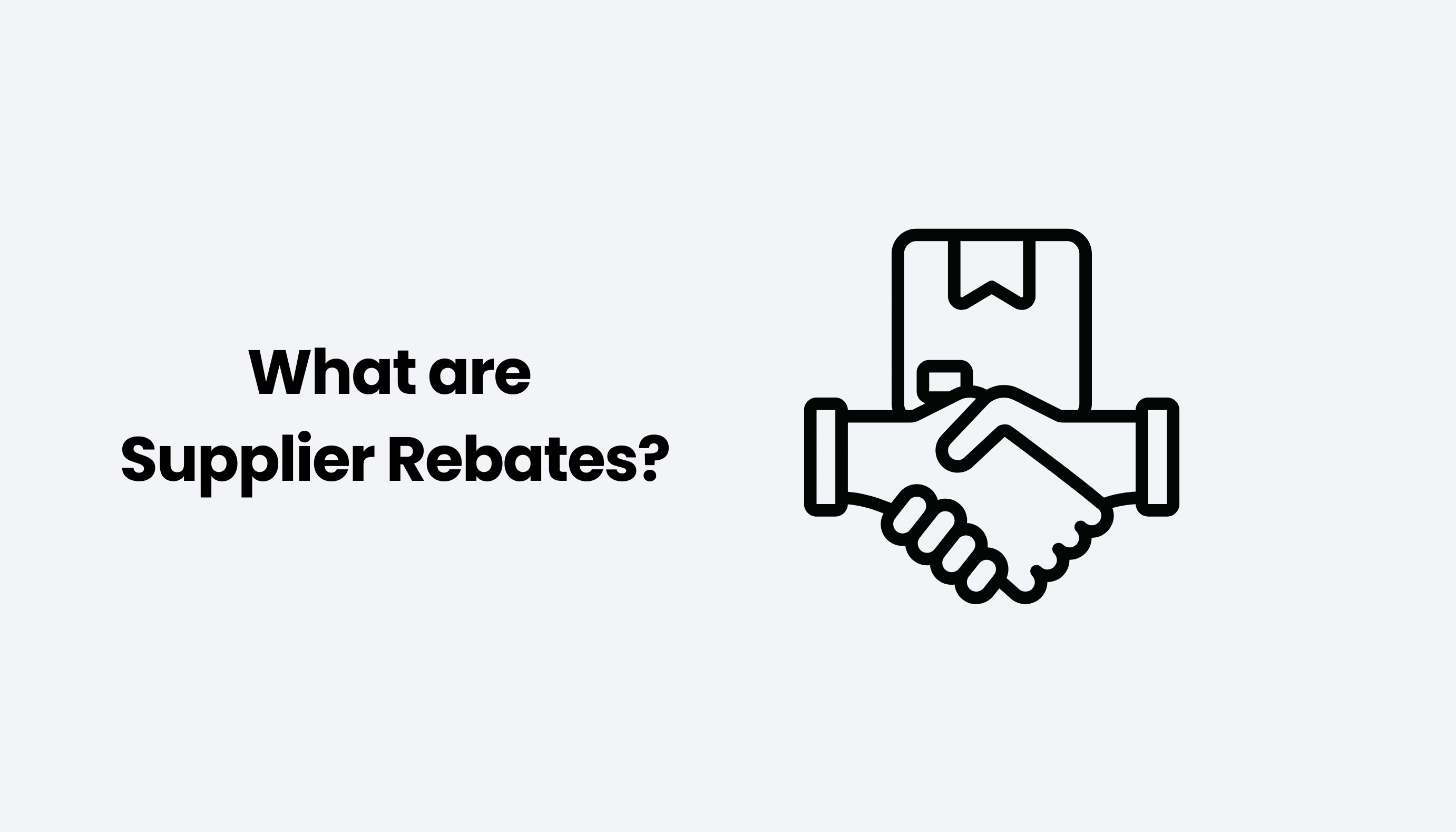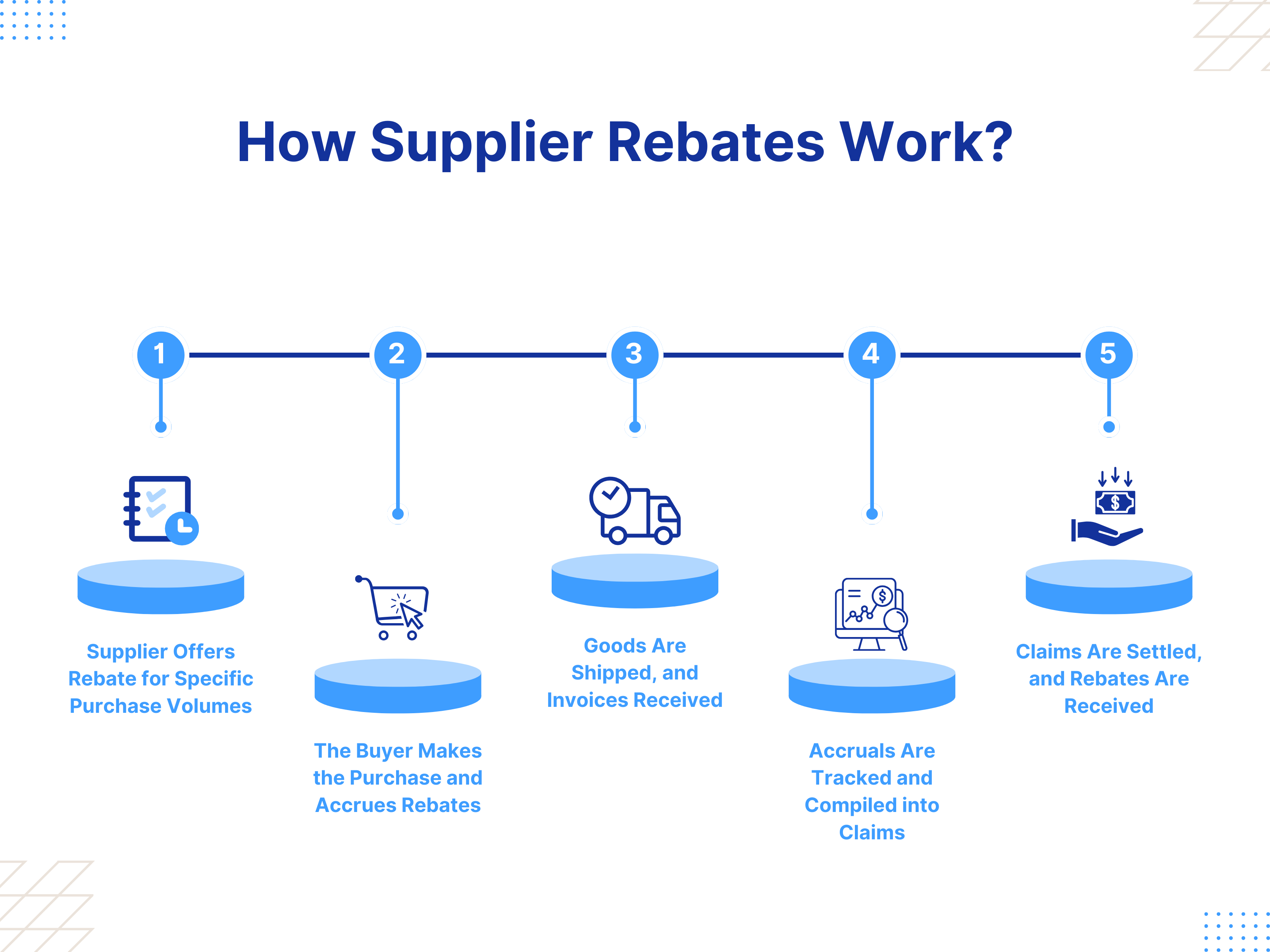What are Supplier Rebates?

Supplier rebates are a common practice in business where a supplier provides financial incentives to a buyer (like a retailer or distributor) after a purchase is made. Unlike discounts, which lower the price upfront, rebates are paid after certain conditions are met like buying a specific volume of goods or meeting sales targets.
Rebates help build strong relationships between suppliers and buyers by offering incentives for businesses to buy more or stick with a particular supplier.
In this blog, we'll explore how supplier rebates work, why they are important, and how businesses can make the most of them.
Table of Contents:
- What are Supplier Rebates?
- Benefits of Supplier Rebates
- How Supplier Rebates Work?
- Supplier Annual Rebate
- Common Challenges in Supplier Rebate Management
- Best Practices for Optimizing Supplier Rebate Strategies
- Supplier Rebate Systems: Why Automation is Key
Jump to a section that interests you, or keep reading.
What are Supplier Rebates?
Supplier rebates are financial agreements in which a supplier returns a portion of the purchase price to the buyer (wholesaler or retailer) once specific purchasing conditions are met.
These conditions involve buying a certain volume of products or reaching a specified spending threshold within a defined period. Rebates are paid after the sale has been completed, which differentiates them from other forms of incentives like discounts or coupons, where price reductions occur at the point of purchase.
An important difference between supplier rebates and discounts is the timing of the financial benefit. While discounts reduce the price upfront, supplier rebates require the buyer to make a full-price purchase and later claim a rebate based on their fulfillment of the rebate terms. Another difference lies in the complexity of rebates. Rebates are offered based on specific conditions, such as eligible products, tiered rebate percentages based on volume thresholds, and other criteria that must be met to qualify for the rebate, which makes them more intricate than a simple discount.
Benefits of Supplier Rebates
For Suppliers:
- Increased Sales: Rebates encourage buyers to purchase more or place larger orders, helping suppliers reach their sales goals.
- Inventory Management: Suppliers can use rebates to promote specific products, which helps manage inventory and prevent overstock.
- Customer Loyalty: Rebates help build customer loyalty by rewarding customers for larger or repeat purchases, giving them a financial reason to keep coming back and strengthening their long-term relationship with the supplier.
- Competitive Advantage: Supplier rebates provide a competitive advantage by offering financial incentives that attract new customers and encourage existing ones to stay, making the supplier more appealing compared to competitors who may not offer similar rewards.
- Targeted Growth: Suppliers can use rebates to drive sales of specific products or product mixes by aligning rebate programs with business growth objectives.
For Buyers:
- Cost Savings: Buyers earn back a portion of their purchase costs through rebates, which improves their profit margins by lowering the overall costs of purchased products.
- Increased Profitability: Rebates significantly contribute to the bottom line, especially for businesses with large or frequent purchases by recovering a portion of their spending after meeting specific purchasing conditions
- Flexibility in Product Selection: Buyers can focus on purchasing products that qualify for the highest rebates to optimize their inventory for profitability.
- Improved Financial Performance: By leveraging rebates, buyers can better manage their procurement costs and improve overall financial efficiency.
How Supplier Rebates Work?

Supplier Offers Rebate for Specific Purchase Volumes
The rebate process begins when a supplier offers a rebate agreement to a buyer based on purchasing certain volumes of products within a set timeframe. These agreements include specific terms, such as eligible products and target purchase amounts, that the buyer needs to meet in order to earn the rebate.
The Buyer Makes the Purchase and Accrues Rebates
Once the buyer commits to the agreement and starts purchasing the specified products, rebate accruals begin. Each time a purchase is made that qualifies under the rebate agreement, the buyer earns a portion of the rebate based on the purchase volume or value. The accrual process tracks the rebates earned for each purchase in real-time or at the time of invoicing.
Goods Are Shipped, and Invoices Received
After the buyer places an order, the supplier ships the goods and sends an invoice for the shipment. At this stage, accruals are typically earned once the invoice is received, reflecting the buyer’s qualifying purchases. In some cases, accruals can be earned upon the receipt of goods, depending on the terms of the rebate program.
Accruals Are Tracked and Compiled into Claims
The next step is tracking these earned rebates over time. The accruals are monitored and compiled into claims that the buyer will later submit for approval. This tracking is important for ensuring that all eligible rebates are properly recorded and ready for the final claim submission. Accurate tracking is important to avoid discrepancies when submitting claims.
Claims Are Settled, and Rebates Are Received
Once enough accruals have been compiled, the buyer submits a claim to the supplier to receive the rebate. The supplier reviews the claim and, once approved, settles it by providing the rebate, either through a payment or a credit. In the event of a dispute or a rejection, adjustments are made to resolve any issues. After the claim is settled, the rebates are officially received by the buyer, and the process is complete.
Automated rebate management systems help simplify this process by handling accruals, claims, and settlement tasks with greater accuracy and speed.
Supplier Annual Rebate
In a supplier annual rebate program, a wholesaler or retailer buys products from a supplier over a set period, usually a year. Unlike regular supplier rebates, which apply to individual transactions, annual rebates accumulate based on total yearly purchases.
For instance, a supplier offers different rebate tiers depending on the total value of purchases. A buyer receives a 3% rebate for spending under $1 million, 5% for purchases between $1 million and $2 million, and 8% for purchases exceeding $2 million. These tiers motivate buyers to increase their orders to achieve higher rebate percentages.
Here’s how it works:
- Rebate Offer: The supplier offers or negotiates an annual rebate with the wholesaler/retailer.
- Purchasing: The wholesaler/retailer buys products from the supplier, and the supplier ships the goods.
- Invoicing & Tracking: The wholesaler/retailer receives invoices and tracks total purchases throughout the year.
- Accrual Calculation: Rebates are calculated based on purchase volume, either as a percentage of total value or as a fixed amount per unit, depending on quantity thresholds. These calculations can be done retrospectively or in steps.
- Claims Review: The accrued rebates are compiled into claims, which are then reviewed and approved.
- Settlement: The claims are settled by issuing debit memos or payments, adjusted if any supplier rejections occur.
Common Challenges in Supplier Rebate Management

Managing supplier rebates comes with several challenges due to the complexity and customization of rebate agreements.
One of the primary difficulties is dealing with complex rebate terms. Rebate agreements are often tailored to specific business goals, with conditions like tiered purchase thresholds, product-specific eligibility, and varying rebate percentages. This level of detail makes it hard to manage rebates manually, especially when terms differ across multiple buyers and products.
Another major challenge is tracking multiple products and transactions. Rebate programs cover a wide range of products, each with its own specific requirements. Accurately tracking all purchases that qualify for rebates, along with matching them to the right terms, is a time-consuming task. With large volumes of data to manage, errors in tracking lead to missed rebates or overpayments, both of which can significantly impact a company’s bottom line.
Accrual tracking also presents a challenge. Businesses need to monitor rebate earnings as they accrue throughout the purchasing cycle. Without accurate tracking of accruals, it becomes difficult to determine whether a buyer is on track to meet the rebate thresholds. Mismanaged accruals will result in under-claiming rebates, leading to lost revenue or over-claiming, which can cause disputes with suppliers.
Claim processing is another critical area prone to difficulties. When rebates are managed manually, processing claims becomes highly error-prone. Inaccurate claims result in margin leakage, where companies fail to claim the full value of their rebate entitlements. Furthermore, incorrect or incomplete claims are rejected by suppliers, delaying the rebate process and reducing financial returns. Automating the claims process helps ensure accuracy and reduces the likelihood of rejected claims.
Finally, channel accounting poses challenges in managing rebates efficiently. Businesses must integrate their rebate management systems with their accounting tools to ensure smooth rebate realization. Automating the accounting process reduces the time and cost involved in managing rebate claims. However, failing to complete this integration led to delays in processing claims, missed rebate deadlines, and costly errors.
Best Practices for Optimizing Supplier Rebate Strategies
Here are some best practices to help maximize the benefits of supplier rebates:
1. Centralize Rebate Agreements
For suppliers, centralizing all rebate agreements in one system provides full visibility and control over the various rebate programs they offer. Suppliers can track the terms, conditions, and performance of every agreement from one place to ensure no inconsistencies across deals with different customers.
This centralization helps avoid mistakes like offering conflicting rebate terms to different buyers and ensures smooth management of all rebate contracts.
2. Use Automation to Manage Rebate Data
Automation is essential for suppliers to handle the complexities of multiple rebate agreements. Suppliers reduce the risk of manual errors by automating rebate tracking, calculations, and claims processes.
Automated systems also help simplify the entire rebate lifecycle, from offer setup to payout, allowing suppliers to quickly and accurately process rebates without delays. This also minimizes the workload on finance teams, ensuring that rebate payouts are timely and aligned with the terms of each agreement.
3. Ensure Data Transparency and Collaboration
Clear communication and collaboration between suppliers and buyers are essential for successful rebate management. Both parties must ensure they are working with the same data and rebate agreements consistently. Maintaining transparency in data sharing and reporting helps prevent misunderstandings and disputes later in claim processing. Using systems that provide both sides with real-time visibility into rebate earnings and terms reduces the likelihood of errors, speeds up rebate claims, and strengthens long-term relationships.
4. Regularly Review and Update Rebate Agreements
Rebate agreements should be reviewed regularly to ensure they still align with the business’s goals and market conditions. Suppliers and buyers must work together to renegotiate terms as necessary, especially if sales targets, product lines, or purchasing behavior changes over time. Adjusting rebate agreements to reflect current business realities ensures that the rebate strategy remains beneficial for both parties.
5. Use Tiered and Volume-Based Programs
Tiered rebate structures, where buyers earn higher rebates as they purchase more, can be highly effective in motivating buyers to increase their order volumes. Suppliers should ensure their rebate strategies include volume-based incentives to encourage long-term purchasing commitments from buyers. Offering greater rebates for higher purchase levels incentivizes customers to buy more, benefiting both the supplier and the buyer.
Supplier Rebate Systems: Why Automation is Key
Automating supplier rebate systems is essential for managing the complexities of modern rebate programs. Supplier rebates involve detailed agreements with specific product eligibility, volume thresholds, and time-based conditions, all of which require precise tracking and accurate calculations. Without automation, managing these processes manually becomes cumbersome, prone to errors, and inefficient, leading to missed opportunities and financial losses.
Speedy Labs’s rebate management software provides an all-in-one solution to these challenges. With Speedy Labs, suppliers can easily manage, track, and scale their rebate programs, turning what used to be a complex process into a smooth, automated system. Speedy Labs ensures accurate rebate tracking in real time, eliminating the risk of manual errors and missed rebates. The platform allows suppliers to track purchases, calculate rebates automatically, and ensure that all eligible rebates are captured correctly, which helps to prevent overpayments or disputes.
With a focus on transparency, efficiency, and scalability, Speedy Labs helps suppliers strengthen customer relationships while maximizing the financial benefits of their rebate programs.
Get in touch today to know more about how our platform will help you simplify and scale your rebate management.
